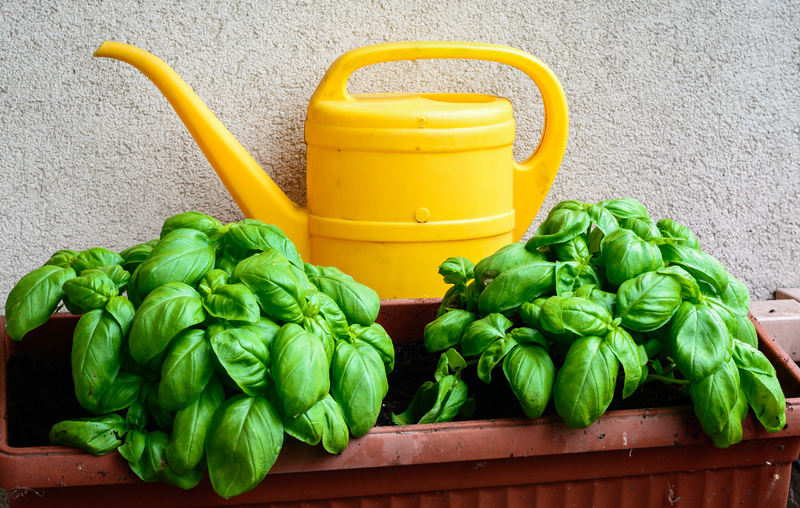A Guide to Artistic Hedge Trimming Shapes and Techniques
Posted on 04/09/2025
A Guide to Artistic Hedge Trimming Shapes and Techniques
In the world of gardening and landscaping, hedges are more than just green boundaries. With a touch of creativity and skilled hands, they can transform into living sculptures. Artistic hedge trimming--often referred to as topiary--infuses your outdoor spaces with elegance, whimsy, and visual interest. If you're aspiring to master the art of shaping hedges, this guide reveals everything you need to know about trimming shapes, methods, and essential tips for stunning results.

Understanding Artistic Hedge Trimming: More Than Just Cutting Back
Before diving into the world of hedge shaping techniques, it's crucial to understand the core principles of artistic hedge sculpting. Unlike standard hedge maintenance, artistic trimming is a blend of horticultural skill, patience, and creative vision. It goes beyond simply keeping bushes neat and looks at every hedge as a canvas for living art.
Why Practice Creative Hedge Trimming?
- Curb Appeal: Artistically-shaped hedges increase property value and attract admiration.
- Personal Expression: Your outdoor space becomes a reflection of your taste and personality.
- Wildlife Benefit: Maintained, diverse shapes can offer shelter and food for insects and birds.
- Therapeutic Activity: The meditative process of shaping greenery is rewarding for many gardeners.
Popular Hedge Trimming Shapes: Classic to Contemporary
Artistic topiary encompasses an array of forms, ranging from classical geometric precision to imaginative animal figures. Whether you're new to artistic hedge shaping or an experienced gardener, consider these popular trimming shapes:
Geometric Hedge Shapes
- Sphere (Ball): One of the most iconic shapes, spheres work for small or large hedges and create an eye-catching focal point.
- Cone: A classic European style; conical shapes add height and a formal, structured look.
- Cuboid/Rectangle: Straight edges give a modern, tidy appearance that complements architectural lines.
- Pyramid: These bring a dramatic, ancient touch to gardens--a challenge for those comfortable with finer details.
Naturalistic and Whimsical Forms
- Animal Topiary: From spiraled snails to proud peacocks, animals are a favorite for intermediate to advanced trimmers.
- Abstract Art: Create freeform waves, spirals, or unique custom shapes for a contemporary garden flair.
- Archways and Tunnels: An entrance of lush green or a whimsical passageway invites wonder into any landscape.
- Letters and Symbols: Personalize your garden with initials, numbers, or meaningful emblems.
Formal Hedge Designs
- Knot Gardens: Intertwined, low hedges that mimic woven or braided patterns.
- Parterres: Ornate, symmetrical designs, often seen in French or Victorian gardens.
- Mazes and Labyrinths: Fun and interactive, these grand designs require careful pre-planning and patience.
Essential Tools for Artistic Hedge Sculpting
Achieving immaculate hedge trimming shapes demands the right tools. Maintaining sharpness and suitability for your project is every bit as important as your creative approach.
- Hand Shears: Ideal for precision work and small, detailed hedges.
- Hedge Trimmers: Electric or manual, these speed up the process for larger or thicker hedges.
- Topiary Frames: Wire templates assist beginners in creating uniform shapes.
- String and Stakes: For straight lines or symmetrical designs, these are invaluable for marking guidelines.
- Pruning Saws: For tackling older, woody branches during formative shaping.
- Gloves and Goggles: Don't forget safety--self-protection is a vital part of the trimming process.
Techniques for Artistic Hedge Trimming: Step-by-Step
1. Choose the Right Plant
- Boxwood (Buxus sempervirens) is perhaps the most popular for artistic hedge shaping due to its dense foliage and slow growth.
- Yew (Taxus baccata) offers flexible shoots and can withstand hard pruning.
- Privet and Lonicera are fast-growing alternatives requiring more frequent trims.
- Consider the climate: Some species fare better in shade, drought, or cold.
2. Formative Pruning: Laying the Foundation
The artistry begins with young plants. Formative pruning encourages thick, bushy growth. In the first 1-2 years:
- Tip prune in early spring to encourage side shoots.
- Remove inward-growing or weak stems.
- Don't worry about the final shape yet--establish density first.
3. Sketch and Visualize
- For complex hedge designs, create a sketch or digital rendering.
- Use stakes, string, and templates as guides, especially for geometric forms.
- Start simple--progress to advanced shapes as your skills improve.
4. Trimming Techniques for Artistic Shapes
Follow these golden rules for the best effect:
- Start at the Top: Work from the highest point down, ensuring the shape drops evenly on both sides.
- Maintain Taper: Keep the hedge wider at the base than at the top; this allows sunlight to reach all leaves uniformly.
- Cut a Little at a Time: Trim in small increments--hedges take years to grow but minutes to cut back too far!
- Step Back Regularly: Every few minutes, step away to assess balance and proportion; this prevents lopsided trimming.
- Use the Right Tools for Detail: For fine details, switch to smaller, precise shears.
- Refine the Edges: Clean, crisp lines define professional topiary art.
5. Maintaining Your Living Sculptures
Artistic hedges need regular attention to maintain their crisp lines and health.
- Frequency: Fast growers may need monthly trims in the growing season; slower species, just 2-3 times a year.
- Water and Fertilizer: Regular watering and balanced feeding keep foliage lush and resilient.
- Pest Management: Monitor for aphids, scale, and fungal problems.
- Winter Protection: In harsh climates, protect delicate shapes from ice and snow damage.
Tips for Achieving Perfect Artistic Hedge Forms
- Plan Your Design: Great results start with a vision. Sketch or use topiary frames for guidance.
- Patience is Key: Hedges take time to grow into shape; think in years, not months, for ambitious designs.
- Study Examples: Look at botanical gardens, castle grounds, or online galleries for inspiration.
- Practice Makes Perfect: Begin on less-visible shrubs before attempting centerpiece projects.
- Keep Tools Sharp: Blunt blades cause ragged cuts, weakening plant health.
Common Mistakes in Artistic Hedge Trimming: Avoid These Pitfalls
- Over-pruning: Taking off more than one-third of the foliage can stress the plant, causing dieback or slow recovery.
- Ignoring Sunlight Needs: Flat-sided hedges may shade lower leaves excessively, resulting in thinning and poor growth at the base.
- Poor Timing: Trimming at the wrong time (such as late autumn) risks frost damage.
- Uneven Symmetry: Rushing the process or skipping measurements results in lopsided shapes.
- Neglecting Aftercare: Skipping watering, feeding, or pest checks invites ongoing issues.
Advanced Techniques and Artistic Innovations in Hedge Sculpting
Innovative Topiary Methods
- Multi-tiered Designs: Achieve depth by stacking shapes or creating "cloud-pruned" forms with layered, rounded clusters.
- Mixed-species Hedges: Combine two or more shrub types to create color contrast and seasonal interest.
- Sculptural Frames: Advanced artists use intricate wire frameworks for highly detailed forms--perfect for animals, vases, or fanciful scenes.
- Living Sculptures: Integrate perennial flowers, vines, or even lights to add seasonal drama.
Eco-Friendly Approaches to Artistic Hedge Trimming
- Wildlife-friendly Edges: Leave some loose or informal sections to encourage biodiversity.
- Organic Practices: Use manual tools and natural fertilizers to reduce environmental impact.
- Composting Clippings: Reuse trimmed foliage for rich, garden-friendly compost.
The Best Time for Shaping and Trimming Artistic Hedges
Timing is crucial for healthy, beautiful results. Late spring and early summer--after the first flush of new growth--are ideal for detailed shaping. Avoid pruning during frost risk or drought periods, and never trim during the hottest parts of the day to prevent leaf burn. Larger, structural cuts are best done in late winter when the plant is dormant and can heal before the growing season.

Frequently Asked Questions About Artistic Hedge Trimming
-
Is artistic hedge trimming suitable for all types of shrubs?
No, but many evergreen species with dense foliage and flexible branches--like boxwood, yew, privet, and holly--are excellent choices. -
How long does it take to develop advanced shapes?
Simple forms might be achieved in one growing season, but intricate designs often take several years to mature fully. -
Can I restore an overgrown hedge into a topiary?
Yes, with time and patience, most overgrown hedges can be gradually reshaped into beautiful designs. -
Do I need professional training?
No, but online tutorials, books, and garden workshops can accelerate your skills and confidence. -
What if I make a mistake?
Plants are resilient. Allow time for regrowth and correct in future trims. Patience is an essential part of artistic hedge sculpting.
Conclusion: Turning Hedges Into Living Art
The joy of artistic hedge trimming lies in its blend of nature, craftsmanship, and imagination. With the techniques and insights above, anyone can transform ordinary shrubs into stunning garden features. Remember, patience is as important as creativity. Over time, your skill will grow alongside your hedges, and every trim will bring you closer to your garden masterpiece.
So grab your shears, sketch a design, and watch as your living sculptures take shape--one careful cut at a time.



